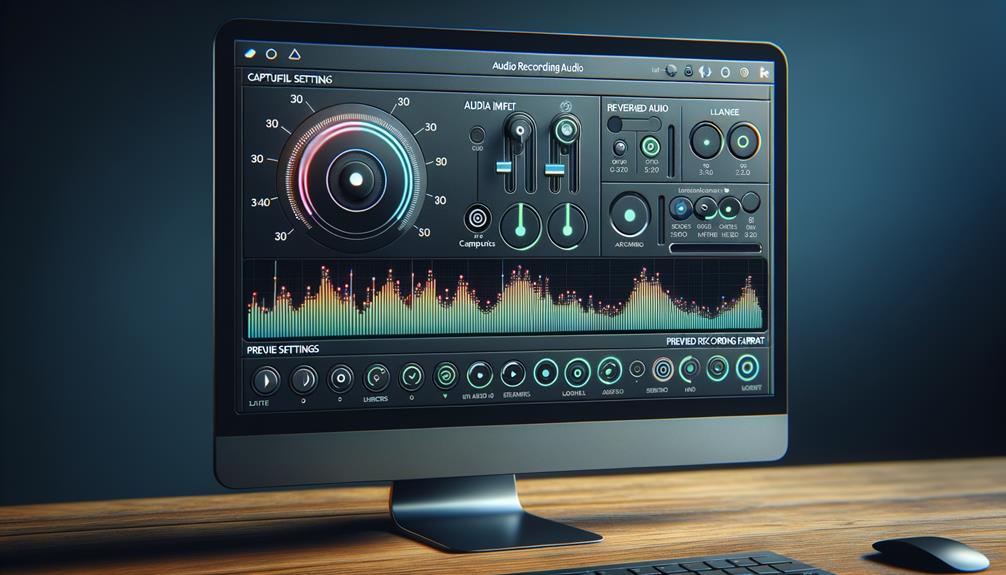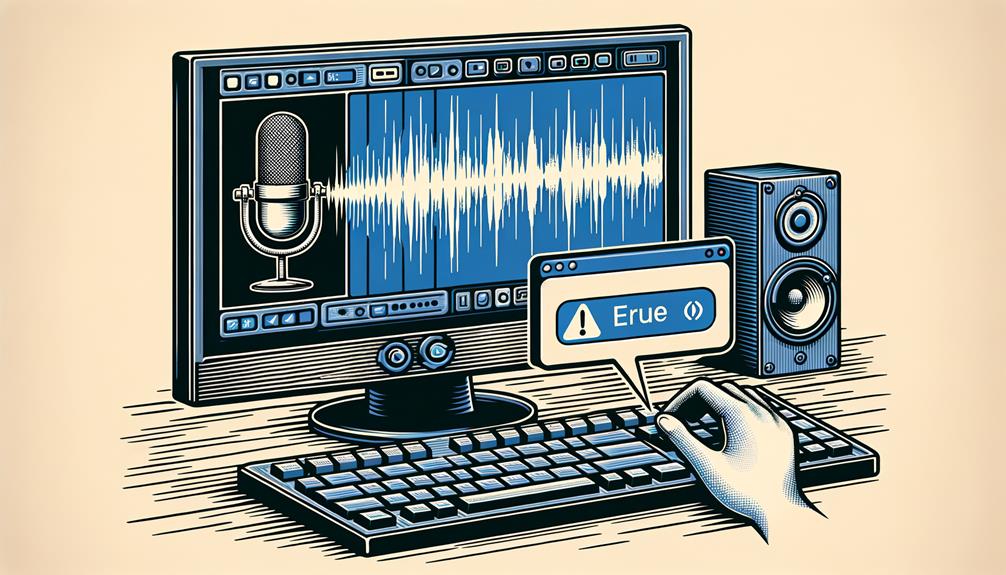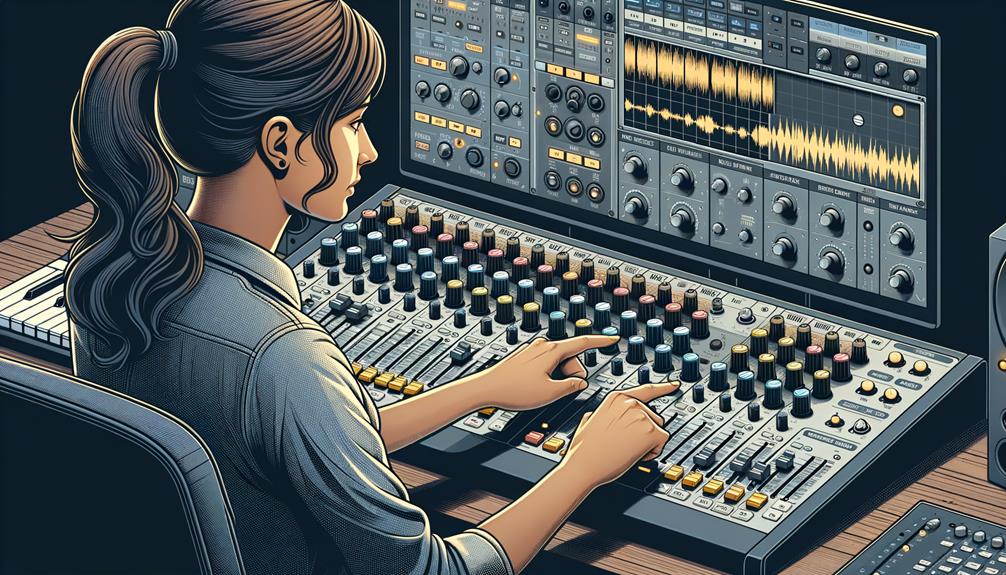No products in the cart.
So, you’ve decided to record computer audio with Audacity and are ready to dive into the process. But before you start, there are a few key steps you need to take in order to ensure a smooth recording experience.
By following these guidelines, you’ll be able to capture the audio you want with precision and clarity. But first, let’s address the initial setup and configuration to get you on the right track.
Contents
hide
Key Takeaways
- Choose the appropriate audio host, recording device, and playback device in Audacity settings.
- Install the latest audio drivers for Windows and enable stereo mix in the Control Panel for capturing computer playback.
- Enable audible input monitoring in Audacity by checking the software playthrough or input playthrough option.
- Consider the desired format before exporting audio in Audacity, such as uncompressed WAV or AIFF for high-quality preservation, or MP3 for compatibility and easy sharing.
Setting up Audacity for Audio Recording
You can configure Audacity for audio recording by selecting the preferred Audio Host, Recording Device, and Playback Device in the settings and choosing the appropriate recording device for computer audio.
When setting up Audacity for audio recording, it’s essential to select the appropriate method of recording in the Audio Host settings. You can choose MME or Windows DirectSound in the Host box for setting up Audacity for audio recording.
In the Recording Device box, you need to find an input for recording computer playback. It’s crucial to ensure that the latest audio drivers for Windows are installed and to check if stereo mix can be enabled in the Windows Control Panel for recording computer playback.
Additionally, when configuring Audacity for audio recording, it’s important to select the correct Playback Device.
Adjusting Computer Audio Settings
When adjusting computer audio settings in Audacity, ensure that the recording device and preferred audio host, recording device, and playback device are configured accurately.
Here are some key steps to adjust your computer audio settings:
- Select the appropriate Audio Host, such as MME or Windows DirectSound, in the Host box for recording computer playback.
- Configure the Windows Control Panel to enable the desired input device, like Stereo Mix, for recording computer playback.
- Choose the loopback input in the Windows WASAPI Audio Host for digital recording without analog conversion.
- Explore alternative applications and troubleshooting methods for recording computer playback, including enabling stereo mix input in audio interface control panels.
Capturing Computer Audio in Audacity

To capture computer audio in Audacity, follow these steps:
- Ensure that you have selected the appropriate recording device and configured the preferred Audio Host, Recording Device, and Playback Device.
- In Audacity, go to the ‘Edit’ menu and select ‘Preferences.’
- Under the ‘Devices’ section, choose MME or Windows DirectSound in the ‘Host’ box.
- Then, in the ‘Recording Device’ box, find an input for recording computer playback.
- It’s important to ensure that the latest audio drivers for Windows are installed to facilitate the recording process.
- When everything is set up, you can click the ‘OK’ button to confirm the changes.
To enable audible input monitoring, follow these steps:
- Click on the ‘Audio Setup’ button.
- Check the ‘Software Playthrough’ or ‘Input Playthrough’ option according to your preference. This will allow you to hear the audio being recorded in real-time.
- Additionally, to ensure that the loopback of the computer’s audio output is still captured, check the system tray for any recording software that may interfere with this process.
- Once all settings are in place, simply click the ‘Record’ button in Audacity and start capturing the desired computer audio.
- Remember to check the ‘Transport Options’ to make adjustments as needed during the recording process.
Saving Computer Audio in Desired Format
Consider the desired format for saving the computer audio in Audacity before proceeding with the export process. Audacity provides various options to export your audio in the format that best suits your needs.
Here are a few methods of recording audio that you can explore:
- Uncompressed WAV or AIFF: If you prioritize high-quality preservation, consider saving the computer audio in these formats.
- MP3: Opt for MP3 format for compatibility and easy sharing of your recorded audio.
- Other Formats: Audacity development has enabled recording in various formats like OGG, FLAC, and others, allowing you to select the particular format based on your specific requirements.
When exporting your audio, ensure that you pay attention to the playback volume and change the device if necessary. By connecting via the appropriate method of recording audio, you can ensure that the exported file meets your expectations in terms of quality and compatibility.
Troubleshooting Common Recording Issues


Experiencing glitches or inconsistencies in your recordings can often be attributed to common issues that can be resolved with a few troubleshooting techniques. When encountering problems while attempting to record desktop audio, it’s essential to check if website restrictions may prevent the achieved recording.
Ensure that the audio levels are at a good level to capture clear sound. In Audacity, if you encounter issues with the audio input, navigate to the ‘Show Disconnected Devices’ option in the audio panel from the Windows Control Panel. This will enable you to view and select your preferred audio device.
Additionally, using Tracks in Audacity allows for precise control over the recording process, ensuring that all elements are captured accurately. If you’re encountering difficulties in recording or distributing material, make sure that the input device is set correctly within the software.
Frequently Asked Questions
Can You Record Desktop Audio With Audacity?
Yes, you can use Audacity for recording desktop audio. Ensure your sound settings are set to capture computer playback. Audacity is compatible and offers good recording quality. For troubleshooting, consider using alternative recording software or external audio interfaces.
How Can I Record Just the Audio From My Computer?
To record just the audio from your computer, adjust the audio settings to capture the computer output. Utilize recording software like Audacity to capture digital audio from various sources, including system sounds and audio playback. Experiment with different recording techniques for optimal results.
Can You Record Audio Directly to Audacity?
Yes, you can record audio directly to Audacity using various recording techniques, adjusting audio settings, ensuring software compatibility, troubleshooting tips for issues, utilizing external devices, selecting audio sources, optimizing recording quality, managing sound output, saving in different file formats, and understanding recording limitations.
Why Is Audacity Not Recording Computer Audio?
To troubleshoot Audacity not recording computer audio, check audio settings, software compatibility, and sound card configurations. Ensure recording permissions, consider alternative methods, and address common issues with hardware requirements and audio sources.
Conclusion
In conclusion, recording computer audio with Audacity requires careful configuration of audio settings and utilizing the appropriate recording method.
By selecting the right audio host and recording device, adjusting computer audio settings, and using the Windows WASAPI loopback recording method, you can successfully capture and save computer audio in Audacity.
Troubleshooting common recording issues and staying updated with the latest audio drivers are essential for a smooth recording process.




